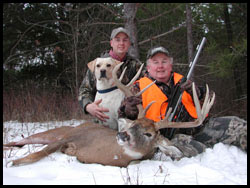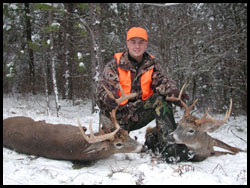
 |
||||||
| Realistic Expectations |
 |
We are often asked, "What can we expect if we follow your advice?". The following excerpt from Craig and Neil Dougherty's book, Grow 'Em Right: A Guide to Creating Habitat and Food Plots addresses this question. |
| Follow the 10 Percent Rule We also try not to get hung up with antler inches. When setting the bar, we use a 10 percent rule. We talk about antler size in inches so we have a common vocabulary, but our goal is to harvest mature bucks that are in the top 10 percent age structure of deer using our property. We advise you to do the same. It sets a reachable standard, and keeps those of us who live in the real world of marginal soils from judging ourselves against standards set for Iowa, Illinois or Kansas. Location does not affect the 10 percent rule, nor does the maturity of the deer and your management program. Some areas of the country grow bigger deer because it's easier for them to grow old. Or maybe deer in that area benefit from exceptional nutrition. At our place, a top 10 percent buck will be a 4 1/2-year-old, 140-class buck. That same 4 1/2-year-old buck in Iowa could be 180 to 190 inches. By thinking in terms of the top 10 percent, you can have a trophy challenge no matter where your property is located and how far you're into your program. You should always be proud of harvesting a top 10 percent buck, even if he nets no more than 90 or 100 points in antler score. We like this sliding scale with its ever-present realistic challenge. Every year we seem to raise the bar a little higher. Three years into our program, we were thrilled to harvest a 21/2-year-old deer. After 12 years in our program, we raised the bar to 3 1/2- and 4 1/2-year-old bucks. Some day, the top 10 percent bucks on our place might be 51/2-year-olds. We have seen bucks on our land with more than 150 inches of antlers. In fact, Craig shot one this size in 2002. Every buck we kill goes on the wall. Katie's 3-pointer is sandwiched between two 2 1/2-year-old bucks, yet it's no less of a trophy than the others. They're all trophies to us. Our sanctuary concept helped the deer reach maturity. Our high-quality food plots increased their weight and antler mass. Our records show a weight increase of 15 percent in the same age and sex categories, when compared to five years before. Rack sizes increased dramatically. We like to think this is because of our quality habitat and hunting program. During bow season the first year we owned the property, we saw seven bucks, including one "rack" buck, a 2 1/2-year-old. We shot no deer that year with a bow. During the firearms season, we shot one 3-point buck. We rejoiced over our first buck kill. We had seven hunters. We did not hunt does. After four years of habitat-development work, we were passing up yearling bucks, and our "shooters" were 21/2-year-olds, 100-class bucks and above. We had increased the percentage of 2 1/2-year-old bucks to 25 percent of all antlered deer sighted. After 12 years in our program, we expected to see three bucks per hunter per sit, and it's not uncommon to have four hunters see 15 different bucks, half of which are 2 1/2-year-olds. In 2002, 65 percent of the 68 different bucks we sighted were 2-1/2 years old or better. Our "shooter bucks" became 3 1/2-year-olds with 125 Pope & Young inches and above. Those are dramatic results, especially for western New York state. Sure, these bucks stray off the property and get shot by neighbors, but interestingly, now that the neighbors know they're likely to see one of "our" bigger deer, they're waiting longer and passing more smaller bucks than ever before. They often wind up "settling" for a doe or two for the freezer. They inadvertently are following the harvest principles of QDM. Happily, some got hooked, joined the QDMA, and now read the magazine and participate in the organization. Even so, we know others are just out there waiting for one of the Doughertys' big ones. We don't get worked up about it. We're just happy more young bucks are growing up in our area. When a neighbor kills one of "our" big bucks, that brings him one step closer to becoming a QDM disciple. Remember one thing when your neighbor kills that trophy you fed and watched all summer: Another will soon be there to take his place. Quality hunting is about lots of things. It's about sitting on a food plot you created, and seeing does and fawns enjoying 35 percent protein forages, watching young bucks sparring and chasing does, and seeing full-racked yearlings instead of spindly spikes. It's about a well-defined rut with scrapes and rubs, and chasing, snorting and grunting. It's about kinship and friendship, and perhaps most of all, it's about stewardship. It adds a special satisfaction that hunting alone cannot deliver. |
 |
But the real rush comes from knowing that a top 10 percent deer is out there, and could step out at any moment. You see his rubs on 6-inch trees and his tracks in the soft earth. Every shift is a duel. You function at heightened awareness, because you know he's out there. He's the one you're after, the one you read about and saw on TV. This excitement, combined with the camaraderie of friends and family, is how we define Quality Deer Hunting. We encourage you to create your own quality hunting experiences. This kind of hunting requires time, commitment, planning and some investment, but it's more than worth it. |
| Join the Quality Deer Management Association We also suggest you join the QDMA so you can enjoy its many benefits. Attend the group's meetings and read its magazine, Quality Whitetails. You will be encouraged by the success stories of QDMA members, and meet people with management goals similar to your own. It's kind of a support group for people like us. We state unequivocally that you'll succeed if you follow the principles and practices outlined in this book. You will create better habitat and, ultimately, will have quality deer and Quality Deer Hunting. If you can persuade your neighbors to follow the same program, everyone will benefit. Quality Deer Hunting is contagious, and even the most skeptical old-timers will come around once they see the proof through success. You owe it to yourself and those you care about most to take a run at it. |